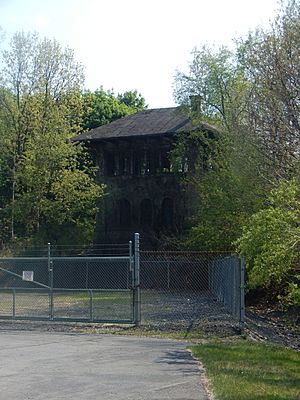Gravel Place, Pennsylvania facts for kids

Gravel Place switching tower, 2015
|
|
| Location | |
|---|---|
| Location | Arlington Heights, Pennsylvania, U.S. |
| Coordinates | 41°01′06″N 75°11′44″W / 41.01833°N 75.19556°W |
| Characteristics | |
| Type | Locomotive |
| History | |
| Opened | 1882 |
| Closed | c. 1950 |
| Original | Delaware, Lackawanna and Western Railroad |
Gravel Place is a spot in Arlington Heights, Pennsylvania. It's about three miles northeast of East Stroudsburg. From the 1880s to around 1950, it was a busy railroad yard for the Delaware, Lackawanna and Western Railroad (DL&W). This railroad connected Hoboken Terminal in New Jersey (serving New York City) to Scranton, Pennsylvania, and then went all the way to Buffalo, New York. Gravel Place was an important stop for trains on this long journey.
Contents
Railroad Connections at Gravel Place
Gravel Place was once a key meeting point for different railroads.
NYS&W Railway Interchange
The New York, Susquehanna and Western Railway (NYS&W) started in 1881. It made a deal with the DL&W railroad. The DL&W would carry coal from mines in northeastern Pennsylvania, near Scranton. This coal would then be handed over to the NYS&W at Gravel Place.
- The NYS&W would then take the coal further east.
- It would go to another railroad in New Jersey.
- Finally, the coal would reach the port of Edgewater, New Jersey.
- From there, it was shipped to customers.
By 1882, the NYS&W had built tracks from Weehawken, New Jersey, to Gravel Place. They even built a bridge across the Delaware River to reach it. Coal hauling began right after the tracks were finished.
Ending the Coal Agreement
After about ten years, the NYS&W decided to change its plans. In 1892, they created a new company called the Wilkes-Barre and Eastern Railroad (WB&E). This new line would go directly to the coal mines.
- The WB&E line was finished in 1894.
- It ran from Stroudsburg to Wilkes-Barre.
- Because of this, the NYS&W removed the short track segment between Stroudsburg and Gravel Place.
- This meant the coal interchange at Gravel Place was no longer needed.
The DL&W Railroad Yard
After the NYS&W connection was gone, Gravel Place became a major yard for the DL&W railroad. A railroad yard is a place where trains are stored, sorted, and serviced.
Yard Facilities and Services
The DL&W built a water tower at Gravel Place around 1900. It also had a place for fueling trains and doing small repairs.
- The main repair center for DL&W was in Scranton.
- But Gravel Place could handle train inspections and minor fixes.
- The yard had a turntable, which is a rotating platform to turn locomotives around.
- It also had a seven-stall roundhouse (a circular building for storing and repairing locomotives).
- There was a special pit for servicing locomotives.
- Freight cars with problems were left at Gravel Place for repair.
- A "cripple track" next to the main line was used for fixing common wheel issues.
- The roundhouse also stored "pusher locomotives." These were extra engines used to help push heavy trains.
Helping Trains Over the Mountains
Westbound DL&W freight trains would stop at Gravel Place. Here, they would get more coal and water. They would also get rid of ash from their engines. This was important before they continued over the Pocono Mountains.
- Pusher locomotives were added to the back of heavy trains.
- They helped push the trains up the steep climb to Pocono Summit.
- Once at the top, these helper engines would uncouple.
- They would then return to Gravel Place.
- These extra engines were very important for moving heavy trains through the mountains.
Other Yard Features
Gravel Place also had pens for livestock. This allowed animals that had been traveling for a long time to rest. The yard grew quite large, becoming about one mile long and 400 feet wide.
- Until 1929, up to 15,000 train cars of coal could be stored here.
- This coal was a backup supply for DL&W steam locomotives.
- It was kept in case there was a miners' strike.
Closing of the Yard
Gravel Place closed in the late 1940s. This was when the DL&W started using new diesel engines. Diesel engines did not need coal or water. This made the old facilities at Gravel Place no longer useful.
The Switch Tower at Gravel Place
Gravel Place also had a special building called a mechanical switch tower. This tower helped control the switching of tracks.
- The concrete tower was built in 1910.
- It had 32 levers.
- These levers controlled the mechanical interlocking systems.
- These systems managed the cripple track, the roundhouse tracks, and other connecting tracks.
- The tower was staffed all the time.
Modernizing the Switches
In 1942, some of the mechanical switching in the area was updated. It became electronic centralized traffic control (CTC).
- Electric motors now operated the mechanical switches.
- Control and signals were sent by wire.
- This allowed fewer people to control more switches.
- The functions of other switch towers, like those at West Henryville and Analomink, were then controlled from the Gravel Place tower.
In 1950, the switches at Gravel Place were also made electric. This meant they could be controlled from far away. The CTC machine was moved to the tower at East Stroudsburg. From there, it controlled the switches at West Henryville, Analomink, and Gravel Place. This left the Gravel Place tower empty. The old tower is still standing today.
Water Supply for the Railroad
The DL&W roundhouse at Gravel Place was the first big customer for the local water company. The Stroudsburg Water Company started in 1867.

